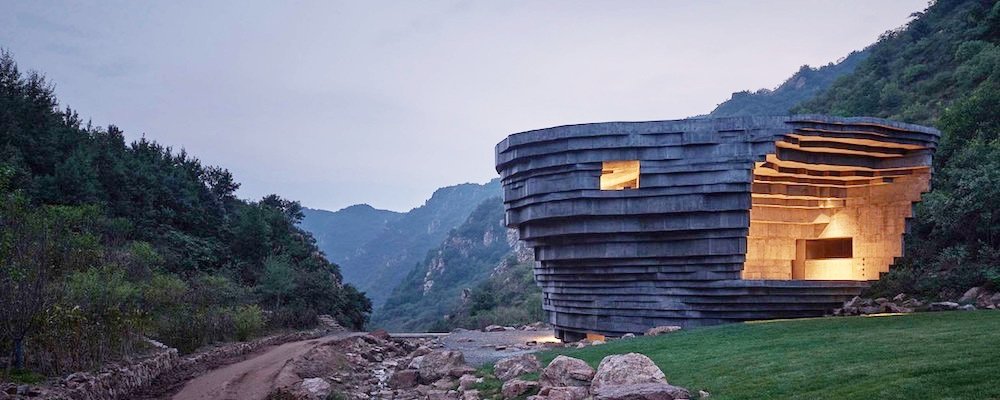Chapel of Sound
Designed by OPEN architecture, this monolithic open-air concert hall overviews the ruins of the Ming Dynasty-era Great Wall, just two hours away from Beijing.
Nestled in a mountainous valley, the Chapel of Sound is built entirely from concrete that is enriched with an aggregate of local mineral-rich rocks, and encompasses a semi-outdoor amphitheatre, outdoor stage, viewing platforms, and a green room.
A Boulder Gently Fallen Into Place
While designed to capture the unfamiliar and deeply touching experience of music performed in the cradle of nature, the Beijing-based architecture office also wanted people just to calm down and listen to the sound of nature, which they believe is profoundly inspiring and healing. When there is no performance, the concert hall is also a tranquil space for contemplation and community gatherings with stunning views of the sky and the surrounding landscape.
This boulder that had gently fallen into place is the creation of OPEN’s founding partners Li Hu and Huang Wenjing who were driven by a desire to minimise the footprint of the concert hall in the valley, creating a structure that was in dialogue with impressive natural landscape, while also feeling undeniably man made.
The resulting rock-like structure is composed of an inner and outer shell with the space between operating like a truss, and was ultimately achieved through close collaboration with international engineering firm, Arup. Formed from concrete, each striation cantilevers out from the previous layer to create the inverted cone shape. Winding staircases weave through the building to a rooftop platform that offers panoramic views of the valley and Great Wall. In the interior spaces, accents of bronze for details such as handrails and doors are used to create a warm contrast against the concrete.
See the Shape of Sound
The brief for the project was very open which inspired the architects to research all aspects of performance, looking at how the behaviours of sound could be a driving force behind the final shape of a building; Li and Huang described wanting to: “see the shape of sound”.
Ultimately, they were drawn to the ways sound reverberates in natural spaces such as caves. Having designed theatres and concert halls, they knew the challenges here was how to create excellent acoustic environment without introducing additional sound absorbing materials. Working with acoustic engineers, OPEN looked at the many ways people will experience sound in the concert hall and defined openings that act both as the sound absorption areas and providing a connection with the exterior environment.
With no heating or air-conditioning, the Chapel of Sound consumes minimum energy, something OPEN was very conscious of when designing the building. The openings also allow the natural elements to come inside, a void in the centre of the rooftop allows daylight to enter the structure and naturally illuminates the performance spaces. When it rains the water will also cascade through the void, however, inspired by the Pantheon, OPEN designed a drainage system that quickly drains the water away.
Li and Huang spent over 10 years training and working in the United States and as a result are very conscious of moving away from traditionally “Eastern” or “Western” ideas of architecture, particularly when it comes to cultural spaces. OPEN understands that the perceived differences in how cultures experience events and spaces are overstated and through their architecture strive to demonstrate that architecture has the power to connect people with each other, with nature, and with our own past and future.
Photographs by Jonathan Leijonhufvud, Runzi Zhu, Nan Ni, Right Angle




























